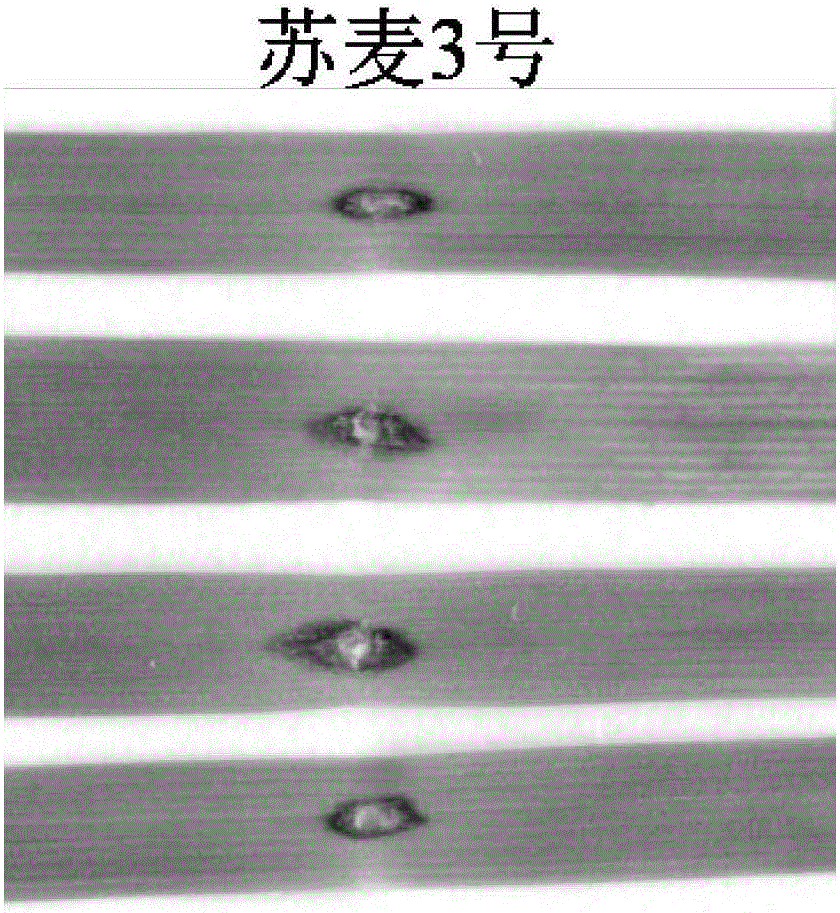Wheat scab resistance identification method
A technology for identification of wheat scab and resistance, which is applied in the direction of biochemical equipment and methods, microbial measurement/inspection, etc., can solve the problems of being easily affected by environmental conditions and personal subjective factors, special requirements for the identification period, and inconsistent identification results. Stability and other issues, to achieve the effect of shortening the identification cycle of disease resistance, improving the efficiency of testing and the stability of results, and speeding up the occurrence of diseases
- Summary
- Abstract
- Description
- Claims
- Application Information
AI Technical Summary
Problems solved by technology
Method used
Image
Examples
Embodiment 1
[0038] Since Sumai No. 3 was bred in 1974, it has been identified and utilized by domestic and foreign scholars for many years. It is agreed that it not only has strong and stable resistance to scab, but also has strong genetic transmission and good combining ability. It is the most widely used source of resistance in disease breeding and genetic research. The Fhb1 gene carried by it belongs to the main QTL for scab type II resistance. It is located on the 3BS chromosome of wheat and has a strong ability to resist scab. It is one of the most widely and deeply studied scab resistance genes. .
[0039] Jimai 22 is a new super-high-yielding, multi-resistant, high-quality medium-gluten wheat variety newly bred by the Crop Research Institute of Shandong Academy of Agricultural Sciences. It is one of the main popularized varieties in my country at the present stage, but it is susceptible to scab. The present embodiment uses these two varieties as research materials, and uses the in...
Embodiment 2
[0049] The scab-resistant gene Fhb7 is derived from the decaploid Thinopyrum elongatum. The inventors of the present invention have identified the resistance to scab-resistant genetically improved materials in greenhouses and fields for many years. Stable and efficient resistance to head blight, so this gene is of great significance to the genetic improvement of wheat head blight resistance. In particular, its improved head blight resistance to Jimai 22 not only retained the excellent yield traits of Jimai 22, but also significantly improved the head blight resistance of Jimai 22. In this embodiment, these two near-isogenic lines are used as research materials, and the inventive method is used to identify its scab resistance. The main steps are as follows:
[0050] 1. Utilize existing technology to obtain conidia concentration to be 1.5-2×10 5 Individuals / mL of typical strong pathogenic Fusarium graminearum PH-1 spore suspension.
[0051] 2. Preparation of identification mat...
Embodiment 3
[0057] When locating the scab resistance gene Fhb7, two wheat-Thinopyrum elongatum substitution line material 7el with different scab resistance ability was used 1 and 7el 2As parents, a RIL population containing 156 lines was created. Fhb7 is derived from the decaploid E. elongatum. The inventors of the present invention have identified the resistance to scab of genetically improved materials in greenhouses and fields for many years. The results show that the gene is stable to scab in materials with different genetic backgrounds. , high-efficiency resistance, so this gene is of great significance to the genetic improvement of wheat head blight resistance. In this embodiment, the RIL population is used as the research material, and the method of the invention is used to identify its scab resistance. The main steps are as follows:
[0058] 1. Utilize existing technology to obtain conidia concentration to be 1.5-2×10 5 Individuals / mL of typical strong pathogenic Fusarium gram...
PUM
| Property | Measurement | Unit |
|---|---|---|
| Concentration | aaaaa | aaaaa |
| Length | aaaaa | aaaaa |
| Length | aaaaa | aaaaa |
Abstract
Description
Claims
Application Information
 Login to View More
Login to View More - R&D
- Intellectual Property
- Life Sciences
- Materials
- Tech Scout
- Unparalleled Data Quality
- Higher Quality Content
- 60% Fewer Hallucinations
Browse by: Latest US Patents, China's latest patents, Technical Efficacy Thesaurus, Application Domain, Technology Topic, Popular Technical Reports.
© 2025 PatSnap. All rights reserved.Legal|Privacy policy|Modern Slavery Act Transparency Statement|Sitemap|About US| Contact US: help@patsnap.com



